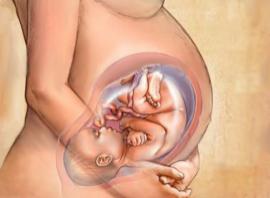From the very beginning of pregnancy and up to the end of its is formed and operates system, the mother-placenta-fetus. The most important component of this system is the placenta, which is a complex organ, in the formation which participated derivatives of trophoblast and embryoblast and decidua tissue.
The function of the placenta, primarily aimed at ensuring adequate conditions for the physiological course of pregnancy and normal fetal development. These features include: respiratory, nutritional, excretory, protective, endocrine.
All metabolic, hormonal, immune processes during pregnancy are provided through the vascular system of the mother and fetus. Despite the fact that blood mother and fetus is not mixed because they are separated by the placental barrier, all the necessary nutrients and oxygen the fetus receives from maternal blood. The main structural component of the placenta is the villous tree.
In normal development of pregnancy there is a dependence between the growth of the fetus, its weight and size, thickness, weight of the placenta. Up to 16 weeks of pregnancy, development of the placenta outpaces the growth of the fetus.
In case of death of the embryo (fetus) occurs deceleration of growth and development of the of chorionic villi and progression involutionally-dystrophic processes in the placenta. Having achieved the necessary maturity in 38-40 weeks of pregnancy, in the placenta is ending the formation of new vessels and naps.
The placenta and the umbilical cord connects the fetus, which is a threadlike education. The umbilical cord contains two arteries and one vein. By two arteries of umbilical flowing oxygen-depleted blood from the fetus to the placenta.
The umbilical vessels are surrounded by a gelatinous substance, which was called "Wharton's jelly." This substance helps cushion the umbilical cord, protects blood vessels and provides power of the vessel wall.
Placenta, fetal membranes and the umbilical cord together form afterbirth, which is banished from the uterus after childbirth.
hide
 Fetal Medicine & Maternal Medicine - it is an integral part of the Perinatology, includes observation of the pregnant woman and the fetus, detection of diseases fetal, treatment or correction, as well as, if necessary, adaptation of children to life after birth.
Fetal Medicine & Maternal Medicine - it is an integral part of the Perinatology, includes observation of the pregnant woman and the fetus, detection of diseases fetal, treatment or correction, as well as, if necessary, adaptation of children to life after birth. 






